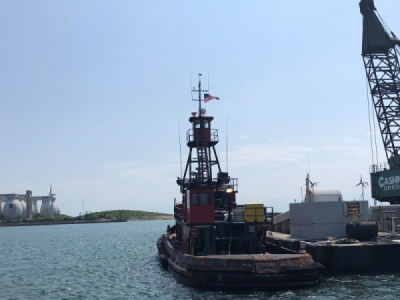
Posted on April 9, 2019
William P. Doyle, CEO & Executive Director of the Dredging Contractors of America commented on the milestones reached: This is what it’s all about. Moving mud. Phases I and II of the Boston Harbor deepening projects sail past the mile-markers. A lot of stakeholders are involved with making this massive dredging project a success. Boston imports and exports. It’s positioned as a key point of worldwide commerce for cargo transiting both the expanded Panama and Suez Canals.
U.S.-Flag dredging companies Cashman Dredging and Marine Contracting, Dutra Group and Great Lakes Dredge & Dock make it all work.
The U.S. Army Corps of Engineers, New England District, announced the dredging milestone on April 5, 2019, where Cashman Dredging and Dutra Group surpassed 4 million cubic yards of dredge material removed as part of Phase II of the three-phased Boston Harbor Navigation Improvement Project in Boston, Massachusetts. Approximately 7.7 million cubic yards of dredge material and weathered rock, and 200,000 to 500,000 cubic yards of hard rock remain to be removed before the project is fully completed by December 2021.
 The project would not be possible without the support of the project sponsor, Massport, and the exceptional partnerships and coordination between the Corps of Engineers, Massport, U.S. Coast Guard, Boston Pilots Association, Boston Logan International Airport, lobstermen, recreational
The project would not be possible without the support of the project sponsor, Massport, and the exceptional partnerships and coordination between the Corps of Engineers, Massport, U.S. Coast Guard, Boston Pilots Association, Boston Logan International Airport, lobstermen, recreational  users, and many others.
users, and many others.
The Boston Harbor improvement and deepening project has been many years in the making, through the study, analysis and planning phases, design and now construction. “The project involves deepening and improving various portions of the Boston Harbor Federal Navigation Project,” said Project Manager Jenifer Thalhauser, with the Corps of Engineers, New England District, Programs and Project Management Division in Concord, Massachusetts. “Project benefits will be realized with reduced tidal delays for cargo vessels and the capability of the Port of Boston to receive larger cargo ships which will benefit both regional and national commerce.”
This is a three phase project. Phase 1 (completed) involved constructing a Confined Aquatic Disposal (CAD) cell by dredging 1,000,000 cubic yards of material and disposing of that material at the Massachusetts Bay Disposal Site. Once the CAD cell was constructed, maintenance dredging of approximately 800,000 cubic yards of silty material from portions of the 40-foot Main Ship Channel, the 40-foot deep Inner Confluence, and portions of the 35-foot deep channel, were placed into the newly constructed CAD cell. The $12.8 million contract was awarded to Great Lakes Dredge and Dock of Oak Brook, Illinois, in September 2016. Construction started in July 2017 and was completed in December 2017.

Mechanical Camshell Dredge vessel DALE PYATT transferring dredged material to scow barge, July 2018.
Phase 2 (currently ongoing) involves dredging 11.7 million cubic yards of silt, blue clay, till and weathered rock. The $122.2 million contract was awarded to the Joint Venture of Cashman Dredging, Inc. and Dutra Group in February 2018. Construction started in July 2018 and is anticipated to be completed in October 2021. The milestone of dredging 4 million cubic yards of material for phase 2 was reached on April 5, 2019.
“The federal navigation improvement project will allow the Port to accommodate large container ships that are calling on the U.S. east coast now that the Panama Canal improvements are completed,” said Thalhauser.
Approximately 11.7 million cubic yards of material will be removed from the following components of the Boston Harbor Federal Navigation Project: deepening and widening the Broad Sound North Channel to -51 feet Mean Lower Low Water (MLLW); deepening and widening the Main Ship Channel to the Conley Terminal, including the turning basin to -47 feet MLLW; and deepening the President Roads Anchorage and deepening the lower Reserved Channel to -47 feet MLLW.

24-7-365– around the clock dredging. Great Lakes Dredge and Dock Company on the job, Phase I, Boston Harbor. (Photo, North End Waterfront .COM)
The dredge material is being placed in the Massachusetts Bay Disposal Site (MBDS), approximately 20 miles offshore of Boston Harbor, with the exception of a small fraction of the material that was placed as a cap to the Main Ship Channel Confined Aquatic Disposal (CAD) cell, just downstream of the inner confluence of the Chelsea and Mystic Rivers.
Phase 3 (future work) will involve removing approximately 200,000 to 500,000 cubic yards of hard rock. The contract solicitation is anticipated to be released in spring 2020 with the work getting underway later that year and when finished will then complete the entire Boston Harbor Improvement project. Completion of the entire project is expected by December 2021.

DCA’s William Doyle and Port of Boston Deputy Director, Massport’s, Mike Meyran with the post-Panamax Yang Ming vessel YM UBIQUTY (nearly 9,000 TEU); July 2018 at the commencement of Phase II dredging.
According to Thalhauser, one of the biggest challenges of the project was the extensive coordination required. “It is a very active navigation channel and has required extensive coordination with the U.S. Coast Guard, commuter ferries, Boston Harbor pilots, recreational users, lobstermen, and other construction activities in the Harbor involving Massport and Eversource Energy,” she said. “Also, the proximity to the Logan Airport required extensive coordination with Massport Aviation, FAA and Logan ATCT.”





